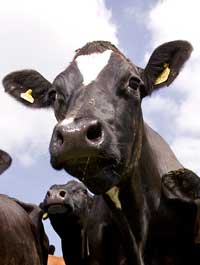Government report calls for longer-lived dairy cows

Improvements to the welfare of dairy cows in the UK have been made, but more must be done to ensure a dairy cow has a life worth living, according to the government’s advisors on farm animal welfare.
A report, entitled an Opinion on the Welfare of the Dairy Cow from The Farm Animal Welfare Council said it was clear cows were living longer, but the industry must drive towards maximising cow life-span and reducing the number of involuntary culls.
“Since our 1997 report, cows are living longer with a lifespan of about six years. And between 1991 and 2005, the average number of lactations has increased from 3.3 to 3.6,” it said.
“This (longer lifespan) is a credit to the dairy industry and is contrary to the belief lifespan has been getting shorter.” And these changes have been made despite outbreaks of major exotic disease and the continued spread of bovine TB.
However, the industry should aspire to a target lifespan of eight years or five to six lactations. “This can be achieved through reducing the number of involuntary culls.”
In the past, most culling was voluntary whereas today, more cows are culled involuntarily, with disease and infertility accounting for 57% of involuntary culls, the report explained.
“The ratio of these two culling strategies is concerning, as the opportunity for voluntary culling for herd improvement is reduced when involuntary culling rates are high.”
The report recognises changes to breeding policy has the long term potential to improve dairy cow health and welfare. “At the time of the last report, farmers… mainly bred cows for high milk yields. Breeding programmes have since changed significantly and now incorporate a wider set of goals.
The current emphasis in the UK is on the inclusion of non-production traits and screening stock for undesirable traits. “But breeding programmes must aim to improve health and welfare rather than just halt their decline.”
The report also called for a centralised recording system for cattle health and welfare. “The UK is one of the few EU countries that does not have a centralised recording scheme… This is a serious handicap, putting the UK at a distinct disadvantage and limiting welfare improvements on dairy farms.”
There is no doubt the low profitability of dairy farming has compromised investment on many farms, which in turn may have compromised cow welfare. “Restoring the profitability of dairying would do much to improve cow welfare,” the report stressed.
Other points covered
Lameness:
- No evidence lameness has improved
- Traditional causes of lameness declined, but new ones taken their place
- Target a prevalence of less than 5%
- Penalising farmers financially for lameness may be an option
Mastitis
- Sub clinical mastitis incidence has increased
- Clinical mastitis has remained static
- More emphasis should be placed on reducing mastitis through transfer of best practice
Infertility
- Major problem
- More attention should be made to heifer rearing to minimise wastage of young cattle
- Infectious diseases
- Bio-security must be integral part of any herd health plan and should be rigidly enforced
Education
- Training of dairy farmers and stockman is essential to promote good welfare
- Staff should feel valued in the work place.
